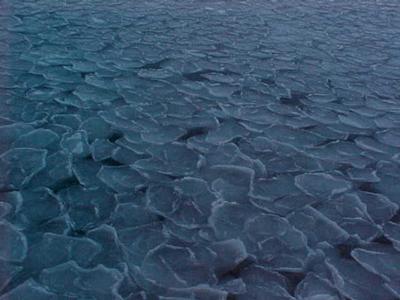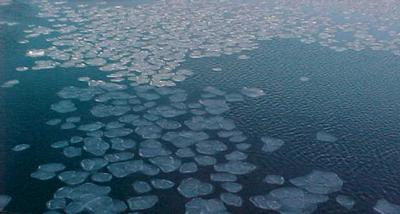24 March, 2001
Tidbit of History
The Revenue Cutter CORWIN, homeport San Francisco headed north in May for
AWS 1881. She made her stop in Unalaska to load supplies and enjoy a stop
at the Elbow Room. Even then the cutters of the Bering Sea Patrol were
multi-mission; search and rescue, law enforcement, medical and supply
centers, to name a few. On this Bering and Arctic cruise, the CORWIN
carried three distinguished naturalists, one of them being John Muir, well
known for his studies on glaciers. In time this practice of transporting
scientists became traditional in Alaskan waters, cutters serve the role of
courier to the scientific world.
Science Observations
Ice isn't just ice as I have discovered. There are many stages and
classifications of ice. I am providing lots of information and definitions
to enable the reader to observe the differences in attached images.
Ice Observations based on the United States Coast Guard:
* Seawater doesn't reach maximum density before it freezes. As a
result, the entire water column down to some depth requires cooling all the
way to the freezing temperature before freezing takes place near the
surface.
* Very low temperatures can cause rapid cooling of the surface layer
and its freezing before mixing can take place.
* Old ice has a greatly reduced salt content compared to first year
ice.
* Sea ice is weaker than fresh water ice and its strength increases as
the salt content decreases also the strength of sea ice increases as its
temperature decreases. Old ice can be 10-40% stronger than first-year ice.
Stages of Growth:
1. New Ice- all categories up through a thickness of 10 cm.
Frazil Ice-represents the first stage in the freezing process,
consists of the fine needles of platelets of ice suspended in seawater.
Slush-consists of snow which is saturated and mixed with water
creating a viscous floating mass of ice crystals within the water.
Grease Ice-the frazil ice crystals have coagulated to form a soupy
layer on the sea surface. It reflects less light and has a dark, matte
appearance.
Shuga-large wind stresses and the accompanying wave agitation
collects grease ice or slush into spongy, white lumps a few cm in diameter.
2. Young Ice-ice that ranges from 10-30 cm thickness.
3. First Year Ice-young ice greater than 30 cm thickness.
Ice Based on Mobility:
Drift Ice-Replaces the historical term "pack ice".
Ice Based on Size and Structure:
As the ice forms it doesn't stay in a single sheet of ice. The effects of
wind, sea, swells current, and tides all act to break up the ice into
pieces. These pieces are named depending on their size.
Pancake ice-consists of roughly circular pieces of ice 30 cm to 3 m
in diameter and up to 10 cm in thickness. The pancakes have a raised rim as
a result of their striking against each other. They develop on a slight
swell from grease ice, shuga, or slush.
Ice cake-is used to describe ice that is relatively flat with the
largest dimensions no greater than 20 meters.
Ice floe-all ice, regardless of age, with a horizontal dimension
greater than 20 meters.
Topography:
Compressional forces within sea ice which results in ice raised above the
normal ice surface.
Rafted ice-ice which has been forced to override other ice as a result of
compression.
Ridge-generally occurs in thicker stages of ice. The ice is fractured and
crushed into fragments which are lifted up and pushed down rather than
sliding on top of the adjacent ice sheet as in rafting. A pressure ridge is
a somewhat irregular pile of ice.
Let's relate floes to real life objects to get a feel of the size.
Small ice cake-size of a pool table top
Ice cake-size of half of a basketball court
Small floe-city block
Medium floe-aircraft carrier deck
Big floe-golf course
Vast floe-small city
Look at the attached pictures and see if you can define the ice based on the
above information before checking the answers.
Daily Update
The temperature is 13 and with the wind-chill it is -39. This is our
coldest day so far! It is so cold out that we are wearing lots of layers of
clothes. No one is staying out very long. I got some wonderful pictures of
the sunrise and of the changing stages of ice formation.
We completed three stations today on our shift. We are more than half way
finished at this point.
The Navy divers are suppose to dive today. It will be a cold day in the
water if they do.
Today is morale day. Many people from the Coast Guard are wearing Hawaiian
shirts. Everyone is suppose to wear a tie for the pizza party at dinner or
pay a quarter for the morale fund. Holly and I had fun making ties out of
duct tape, orange and white labeling tape. I added all sorts of animals and
writing having to do with the CTD sampling. I even have a dolphin
environmentally friendly tie tack that I cut out of a paper cup. Holly drew
the van Veen, spectacled eider and walrus. We'll be ready for dinner
tonight!

<> Pancake ice.

<> Grease ice.

<> What kind of ice is this? Read the description above.

<> Cake ice.
Contact the TEA in the field at
.
If you cannot connect through your browser, copy the
TEA's e-mail address in the "To:" line of
your favorite e-mail package.
|
